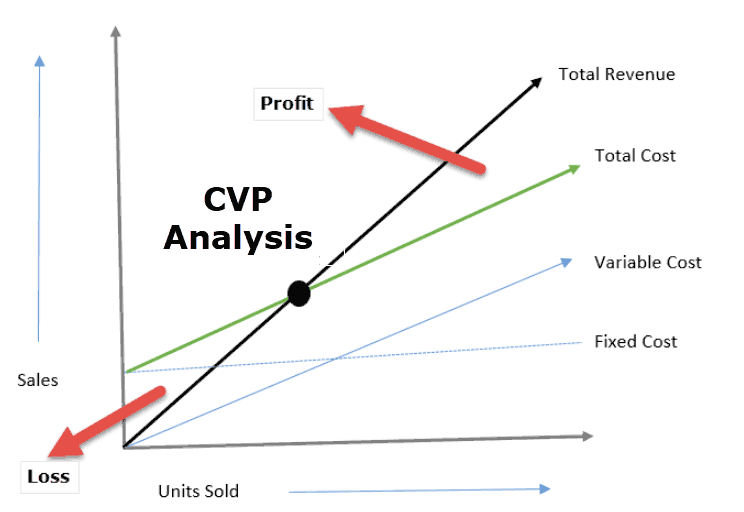Cost-volume-profit (CVP) analysis is a method of cost accounting that looks at the impact that varying levels of costs and volume have on operating profit. The cost-volume-profit analysis, also commonly known as break-even analysis, looks to determine the break-even point for different sales volumes and cost structures, which can be useful for managers making short-term economic decisions.
The cost-volume-profit analysis makes several assumptions, including that the sales price, fixed costs, and variable cost per unit are constant. Running this analysis involves using several equations for price, cost and other variables, then plotting them out on an economic graph.
The cost volume profit analysis, commonly referred to as CVP, is a planning process that management uses to predict the future volume of activity, costs incurred, sales made, and profits received. In other words, it’s a mathematical equation that computes how changes in costs and sales will affect income in future periods.
The CVP analysis classifies all costs as either fixed or variable. Fixed costs are expenses that don’t fluctuate directly with the volume of units produced. These costs effectively remain constant. An example of a fixed cost is rent. It doesn’t matter how many units the assembly line produces. The rent expense will always be the same.

Assumptions of Cash Volume Profit Analysis
Following are the assumptions of CVP Analysis:
(i) No. of Units – Only Driver for Costs and Revenues
It assumes that the total variable costs and revenues would increase or decrease only due to a change in no. of units. There are no factors that will affect it.
(ii) Costs – Either Variable or Fixed
This assumption says that all the costs are either variable or fixed. In other words, it says that there are no semi-variable or semi-fixed costs.
(iii) No Change in Price, Variable Cost, and Fixed Costs
CVP analysis assumes that there are no changes in the price and variable cost per unit irrespective of change in time period and relevant range. If we see closely, it is neglecting the chances of changes in prices due to inflation, economic conditions etc. Also, neglecting the bulk order discounts and small order premiums.
Importance of Cash Volume Profit Analysis
If you are offered a business idea wherein you sell chairs. The first thing few things that will strike your mind is
- Required initial investment
- Amount of sales required to breakeven
- Assess whether you are capable of achieving that sale
This analysis is important because it answers the second most important question. This is not a one time question as well. This is a regular assessment. A businessman has to keep checking whether he is reaching the milestones set as per cost volume profit analysis. This will guide his decision-making process relating to increases in fixed costs, the speed of business operations etc.
Advantages of Cash Volume Profit Analysis
(i) Helps managers find out a breakeven point, target operating income etc.
(ii) Cost Volume Profit technique is used to evaluate investment proposals
(iii) Sets the base for planning the marketing efforts of a business
(iv) Helps in setting up the basis for budgeting activity
Disadvantages of Cash Volume Profit Analysis
(i) In a current dynamic business environment, the costs and prices can’t remain constant throughout the year. A manager is forced to react and make necessary changes in prices and costs due to change in economic conditions, customer bargaining powers, competitors etc.
(ii) All costs cannot be classified as fixed or variable. There is a significant list of costs which are neither fixed nor variable but are semi-variable or semi-fixed. Say, for example, a utility or electricity invoice contains rent as a component which remains constant irrespective of the change in usage of no. of electricity units.
(iii) No. of units cannot be the only driver of total costs and revenues. There are other factors also that impact the prices as well as costs. The raw material price reduction can reduce the variable cost and therefore the customers with knowledge of this change will demand a reduction in prices as well. Similarly, the entrance of a new big player in the market forces all the firms in the market to reduce their cost or compromise or bear loss of customers.
What Does Cost-Volume-Profit Analysis Tell You?
The contribution margin is used in the determination of the break-even point of sales. By dividing the total fixed costs by the contribution margin ratio, the break-even point of sales in terms of total dollars may be calculated. For example, a company with $100,000 of fixed costs and a contribution margin of 40% must earn revenue of $250,000 to break even.
Profit may be added to the fixed costs to perform CVP analysis on a desired outcome. For example, if the previous company desired an accounting profit of $50,000, the total sales revenue is found by dividing $150,000 (the sum of fixed costs and desired profit) by the contribution margin of 40%. This example yields a required sales revenue of $375,000.
CVP analysis is only reliable if costs are fixed within a specified production level. All units produced are assumed to be sold, and all fixed costs must be stable in a CVP analysis. Another assumption is all changes in expenses occur because of changes in activity level. Semi-variable expenses must be split between expense classifications using the high-low method, scatter plot or statistical regression.
3 thoughts on “Cash Volume Profit Analysis”